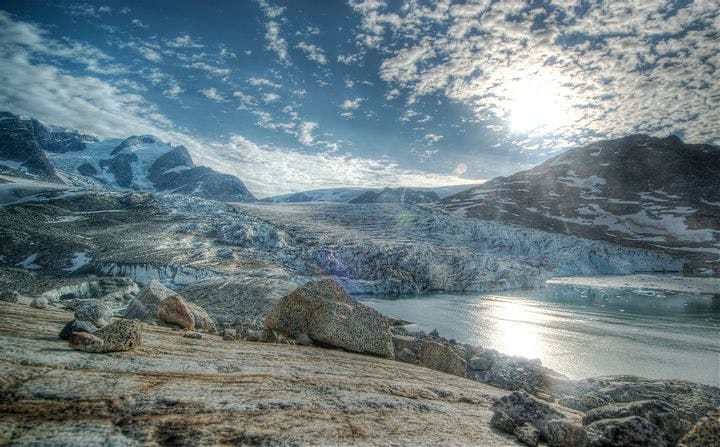Fall 2010
The Frozen Past
– The Wilson Quarterly
The century-long study of ice, a historian says, reveals “the cumulative, insidious, all-pervading power of people on Earth.”
In the three billion years of life on this planet, ours is not the first era of mass extinction and global climate change. But we are the first creatures to live through such upheaval and know what is happening. Much of our understanding comes from studying simple, frozen hydrogen dioxide. The story of ice—how it came to exist in such concentrations at the planet’s poles and what makes up the gases trapped within it—“is the key to understanding climate change,” writes Tom Griffiths, a historian at the Australian National University in Canberra (and no relation to the GriffithREVIEW’s namesake).
The century-long study of ice, a historian says, reveals "the cumulative, insidious, all-pervading power of people on Earth."
The first inklings of the role ice has played in shaping the world emerged in the late 1830s, when Swiss-born scientist Louis Agassiz postulated that large sheets of ice once covered much of the globe. Decades passed before this idea gained wide acceptance. In 1859, Irish researcher John Tyndall went poking into the causes of the Ice Age, examining the gases in the atmosphere to see if they all behaved the same way. He found that not all atmospheric gases are transparent to radiant heat—in particular, carbon dioxide (C02) is opaque—which means that fluctuations in the amount of C02 in the atmosphere could affect how the earth heats and cools. One and a half centuries ago, the role of greenhouse gases in setting the earth’s temperature was flagged. What we know about climate and global warming today began with efforts to understand the climate of eras past and the glaciers that once covered large swaths of Europe.
Griffiths is quick to point out that nothing in the first century of climate research supports the sinister, left-wing conspiracy many global warming skeptics imagine. When scientists did raise the possibility of global warming, “they saw it mostly as positive. . . . Indeed, if the world were warmer, it might make winters more comfortable and agriculture more productive, or even help stave off the next Ice Age. For the first two-thirds of the 20th century the global warming trend was called the ‘embetterment’ of climate, or the ‘recent amelioration.’”
It wasn’t until very recently that scientists began to recognize the peril posed by global temperature fluctuation. There were two key discoveries. First, in the early 1980s, scientists studying the Greenland ice sheet found that climate change had occurred much more quickly than they had assumed was likely, sometimes as much as five or six degrees Celsius within a few decades. Second, the levels of C02 in the atmosphere today are higher than at any time in at least 400,000 years, as indicated by archived ice cores from Antarctica.
Until now, major scientific discoveries have invariably established that humans are less than central actors in the physical world. Copernicus upended the notion that the sun revolves around Earth; geologists and biologists have demonstrated the incredibly recent appearance of Homo sapiens on the planet. By contrast, the century-long study of ice reveals “the cumulative, insidious, all-pervading power of people on Earth,” Griffiths observes.
THE SOURCE: “A Humanist on Thin Ice” by Tom Griffiths, in GriffithREVIEW, Spring 2010.
Photo courtesy of Flickr/Ville Mietinen
